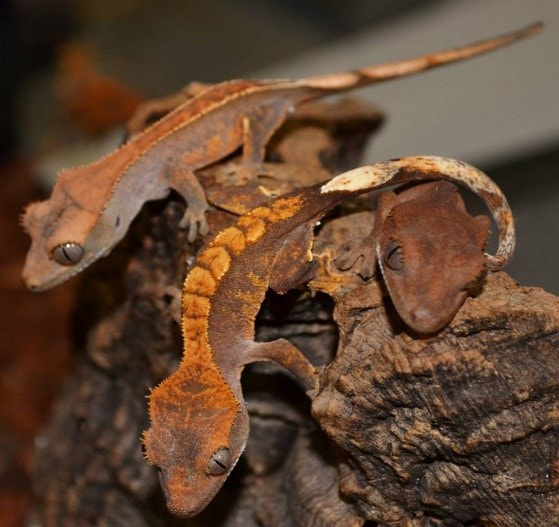Geckos of New Caledonia
By Lindsay Mayer, Veterinary Assistant & Erica Mede McVeigh, CVT
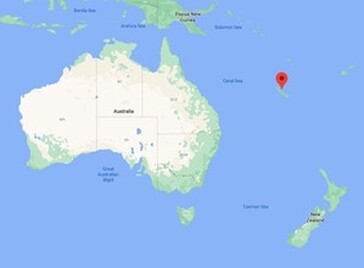
Island Life
Nestled between Australia, New Zealand, Fiji, and New Guinea is a place called New Caledonia; a small island nation in the South Pacific, inhabited by the Kanak people, renowned for its incredible nature, barrier reefs, and perfect climate year-round. It attracts a large tourism industry each year. The biodiversity of this area is of great interest among scientists, much like the Galapagos. Many types of varied terrain create an ideal environment for highly concentrated biodiversity to develop. Currently, the count is over 9,372 distinct species (that’s all in an island chain smaller than the Hawai’ian islands!).
The Geckos
Because these geckos all live within the same narrow range of habitat, they live within the same environmental conditions. The climate of New Caledonia remains fairly constant with little fluctuation -- with temperatures ranging from 70℉ to 85℉ with a constant relative humidity of about 60-70%. Aim to recreate this environment as closely as possible to ensure the health of your new pet. NEVER allow the temperature of the enclosure to fall below 65 or above 85, as these reptiles can become ill and die. (Note: there are many more gecko species endemic to these islands, but generally, only the ones listed on this caresheet are commonly found in the pet trade.) All the geckos below will thrive with access to a low-intensity UVB, carefully monitored humidity, and plenty of foliage/bark/vines to hide in. These geckos rarely drink water from a dish, though a bowl of fresh water should always be provided and changed daily. To ensure that your gecko is getting enough hydration, spray the sides of the enclosure as well as decorations with water once daily; you might even get to see your gecko lick some droplets off the glass! As with any lizard, never grab your pet by the tail, as they can drop their tails when they feel they are in danger. Always use the hand-over-hand method and allow your gecko to freely walk or leap between your hands. Always handle your gecko over a solid surface to minimize risk of falls and injury. All of the following species are solitary and should be housed singly. You will notice that many of their care parameters are very similar. Now, on to the geckos!
Nestled between Australia, New Zealand, Fiji, and New Guinea is a place called New Caledonia; a small island nation in the South Pacific, inhabited by the Kanak people, renowned for its incredible nature, barrier reefs, and perfect climate year-round. It attracts a large tourism industry each year. The biodiversity of this area is of great interest among scientists, much like the Galapagos. Many types of varied terrain create an ideal environment for highly concentrated biodiversity to develop. Currently, the count is over 9,372 distinct species (that’s all in an island chain smaller than the Hawai’ian islands!).
The Geckos
Because these geckos all live within the same narrow range of habitat, they live within the same environmental conditions. The climate of New Caledonia remains fairly constant with little fluctuation -- with temperatures ranging from 70℉ to 85℉ with a constant relative humidity of about 60-70%. Aim to recreate this environment as closely as possible to ensure the health of your new pet. NEVER allow the temperature of the enclosure to fall below 65 or above 85, as these reptiles can become ill and die. (Note: there are many more gecko species endemic to these islands, but generally, only the ones listed on this caresheet are commonly found in the pet trade.) All the geckos below will thrive with access to a low-intensity UVB, carefully monitored humidity, and plenty of foliage/bark/vines to hide in. These geckos rarely drink water from a dish, though a bowl of fresh water should always be provided and changed daily. To ensure that your gecko is getting enough hydration, spray the sides of the enclosure as well as decorations with water once daily; you might even get to see your gecko lick some droplets off the glass! As with any lizard, never grab your pet by the tail, as they can drop their tails when they feel they are in danger. Always use the hand-over-hand method and allow your gecko to freely walk or leap between your hands. Always handle your gecko over a solid surface to minimize risk of falls and injury. All of the following species are solitary and should be housed singly. You will notice that many of their care parameters are very similar. Now, on to the geckos!
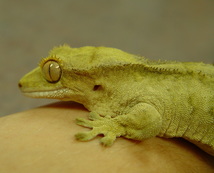
Feeding & Housing Recommendations
Because these geckos are all endemic to the same part of the world, their nutritional and environmental needs are very similar. All of the New Caledonian geckos are omnivores, with fruits and nectars being their primary diet in the wild, and most will eat whatever small invertebrates (even smaller lizards!) walk by.
Powdered diets are commonly sold in pet stores, at reptile shows, and a number are available online. A very popular powdered diet and possibly one of the most balanced diets used by many keepers and breeders is simply called Repashy Crested Gecko Diet and comes in a silver pouch. Powdered diets are mixed with small amounts of water and offered on a plate for ingestion. Some geckos are raised on powdered diets and happily eat the meal whereas those raised on baby food previously can be rather finicky about the change. There are several flavors available for the Repashy diet to help even the pickiest eater convert over. This is a great staple for all of the geckos discussed here. Fruit puree, baby food, and or insects must be dusted with a calcium supplement (one without phosphorous) 3-4 times a week and a multi-vitamin once a week unless a complete powdered diet is being used. Powdered diets tend to be rich in different vitamins and do not require further supplementation. A finely ground powdered calcium/multivitamin supplement is best as it adheres to insects the best.
Geckos in general are eager hunters of insects especially crickets and roaches such as Dubias. If it moves, crested will enjoy it! Meal worms can be used but are rather high in fat whereas prey items like roaches or silkworms are higher in protein. Insects, especially cockroaches and crickets should be gut loaded prior to feeding out. Offering these prey items healthy calcium rich greens such as kale and Swiss chard is required for a positive calcium to phosphorous ratio (this prevents and corrects metabolic bone disease).
A dish of clean water should be offered daily. Some crested geckos will readily drink form dishes while others will lap the dew off leaves and enclosure walls. A shallow water dish will also help to increase the humidity in the enclosure. It is very important that the dish be shallow! These are not lizards that swim.
All of these geckos require a low-level UVB light to recreate the natural sunlight that nature would provide, as it filters down through the tree canopy. It is not recommended to place your gecko’s enclosure near a window, as any UVB gets filtered out by the glass, and the greenhouse effect of the enclosure in a sunny spot can cause dangerously hot temperatures! It can also be drafty and thus it is best to place your gecko’s enclosure in an interior spot in the house. For heat, low-wattage ceramic heat emitters and/or heat mats can be useful in creating the warm side of the enclosure, however they must ALWAYS be used in conjunction with a thermostat -- ceramic fixtures, without regulation, can operate as hot as 300F or more! Heat mats can reach as high as 120F without regulation. Hot temperatures like this will most certainly make for a bad situation for your gecko! Ensure you have a temperature gun (available cheaply at most hardware stores) and thermometers set up at each side of the enclosure to monitor your gecko’s habitat. Never use “heat rocks,” as these can contribute to thermal burns.
Hiding places are necessary for crested geckos to feel secure. Hidings spots, or “hides”, serve as an escape from perceived threats as well as offer a place for the gecko to sleep during the night that simulates their natural sleep spots of hollowed out trees. PVC pipes and paper towel rolls make excellent and inexpensive hides for cresties. An excellent product to use in an enclosure for hides is cork bark which comes in a half log or flat shape. Cork bark is very resistant to rot making it ideal in a high humidity environment that crested geckos inhabit. Branches for climbing can be driftwood and have a hollow in them also for sleeping quarters.
Plants, whether fake or real, are essential for crested geckos to feel secure and offer enrichment as well. Real plants should be non-toxic and potted. It is possible to set up a vivarium with the plants growing from the substrate, but it makes cleaning much more difficult. Natural vivariums have the benefit of being beautiful and enriching for the gecko. A drainage layer is necessary and is generally made of gravel. Natural plants help keep the humidity higher naturally whereas fake plants are much easier to clean if they are soiled and require no special care at all. Birds nest fern, staghorn fern, and dwarf tree fern are commonly used live plants in natural enclosures. Fake plants can be purchased from pet stores, craft stores, and even the local dollar store. With a little ingenuity and creativity keepers can create beautiful fake vivariums.
Ensure that the humidity of the enclosure remains appropriate for each species (between 50-70%, with species specific variants depending on habitat). This can be maintained using a hand spray bottle, sphagnum moss, or an automatic fogger/mister. Always use distilled water in your automatic misters, as hard water buildup can accumulate in your light/heat fixtures as the water evaporates and cause a fire hazard! Always utilize a hygrometer, which measures humidity levels in the enclosure. You can also offer a small hide at the bottom of the cage lined with paper towel or sphagnum moss, and ensure it stays moist. This provides a higher spot of humidity for your gecko to use at will when it is time to shed. Too little humidity is the most common reason that geckos have difficulty shedding. A 10–15-minute warm water soak may also be beneficial for geckos in shed.
Because these geckos are all endemic to the same part of the world, their nutritional and environmental needs are very similar. All of the New Caledonian geckos are omnivores, with fruits and nectars being their primary diet in the wild, and most will eat whatever small invertebrates (even smaller lizards!) walk by.
Powdered diets are commonly sold in pet stores, at reptile shows, and a number are available online. A very popular powdered diet and possibly one of the most balanced diets used by many keepers and breeders is simply called Repashy Crested Gecko Diet and comes in a silver pouch. Powdered diets are mixed with small amounts of water and offered on a plate for ingestion. Some geckos are raised on powdered diets and happily eat the meal whereas those raised on baby food previously can be rather finicky about the change. There are several flavors available for the Repashy diet to help even the pickiest eater convert over. This is a great staple for all of the geckos discussed here. Fruit puree, baby food, and or insects must be dusted with a calcium supplement (one without phosphorous) 3-4 times a week and a multi-vitamin once a week unless a complete powdered diet is being used. Powdered diets tend to be rich in different vitamins and do not require further supplementation. A finely ground powdered calcium/multivitamin supplement is best as it adheres to insects the best.
Geckos in general are eager hunters of insects especially crickets and roaches such as Dubias. If it moves, crested will enjoy it! Meal worms can be used but are rather high in fat whereas prey items like roaches or silkworms are higher in protein. Insects, especially cockroaches and crickets should be gut loaded prior to feeding out. Offering these prey items healthy calcium rich greens such as kale and Swiss chard is required for a positive calcium to phosphorous ratio (this prevents and corrects metabolic bone disease).
A dish of clean water should be offered daily. Some crested geckos will readily drink form dishes while others will lap the dew off leaves and enclosure walls. A shallow water dish will also help to increase the humidity in the enclosure. It is very important that the dish be shallow! These are not lizards that swim.
All of these geckos require a low-level UVB light to recreate the natural sunlight that nature would provide, as it filters down through the tree canopy. It is not recommended to place your gecko’s enclosure near a window, as any UVB gets filtered out by the glass, and the greenhouse effect of the enclosure in a sunny spot can cause dangerously hot temperatures! It can also be drafty and thus it is best to place your gecko’s enclosure in an interior spot in the house. For heat, low-wattage ceramic heat emitters and/or heat mats can be useful in creating the warm side of the enclosure, however they must ALWAYS be used in conjunction with a thermostat -- ceramic fixtures, without regulation, can operate as hot as 300F or more! Heat mats can reach as high as 120F without regulation. Hot temperatures like this will most certainly make for a bad situation for your gecko! Ensure you have a temperature gun (available cheaply at most hardware stores) and thermometers set up at each side of the enclosure to monitor your gecko’s habitat. Never use “heat rocks,” as these can contribute to thermal burns.
Hiding places are necessary for crested geckos to feel secure. Hidings spots, or “hides”, serve as an escape from perceived threats as well as offer a place for the gecko to sleep during the night that simulates their natural sleep spots of hollowed out trees. PVC pipes and paper towel rolls make excellent and inexpensive hides for cresties. An excellent product to use in an enclosure for hides is cork bark which comes in a half log or flat shape. Cork bark is very resistant to rot making it ideal in a high humidity environment that crested geckos inhabit. Branches for climbing can be driftwood and have a hollow in them also for sleeping quarters.
Plants, whether fake or real, are essential for crested geckos to feel secure and offer enrichment as well. Real plants should be non-toxic and potted. It is possible to set up a vivarium with the plants growing from the substrate, but it makes cleaning much more difficult. Natural vivariums have the benefit of being beautiful and enriching for the gecko. A drainage layer is necessary and is generally made of gravel. Natural plants help keep the humidity higher naturally whereas fake plants are much easier to clean if they are soiled and require no special care at all. Birds nest fern, staghorn fern, and dwarf tree fern are commonly used live plants in natural enclosures. Fake plants can be purchased from pet stores, craft stores, and even the local dollar store. With a little ingenuity and creativity keepers can create beautiful fake vivariums.
Ensure that the humidity of the enclosure remains appropriate for each species (between 50-70%, with species specific variants depending on habitat). This can be maintained using a hand spray bottle, sphagnum moss, or an automatic fogger/mister. Always use distilled water in your automatic misters, as hard water buildup can accumulate in your light/heat fixtures as the water evaporates and cause a fire hazard! Always utilize a hygrometer, which measures humidity levels in the enclosure. You can also offer a small hide at the bottom of the cage lined with paper towel or sphagnum moss, and ensure it stays moist. This provides a higher spot of humidity for your gecko to use at will when it is time to shed. Too little humidity is the most common reason that geckos have difficulty shedding. A 10–15-minute warm water soak may also be beneficial for geckos in shed.
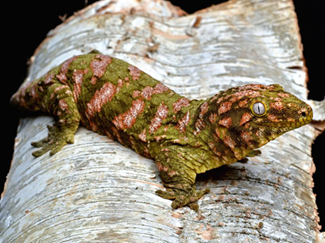
Leachianus Gecko
(Rhacodactylus leachianus leachianus, R. leachianus henkeli)
Photo credit: Mark Orfus, Northern Gecko Inc.
QUICK FACTS
LIFESPAN
15-20 years
SIZE
8-15”
DIET
Primary frugivore, some insects
TEMPERATURE
Low 70-75℉, High 80-85℉
HUMIDITY
60-70%
HABITAT
Arboreal
(min 18x18x24 for most subspecies)
The Leachianus, or “leachie” as they are affectionately known by hobbyists, are the largest in the world and come in many visually striking patterns and colors. They have stout, thick bodies, large heads, and stocky legs. Also called “New Caledonian Giant Geckos”, the leachie has gained popularity in the exotic pet trade over the last couple of decades as captive bred animals have become more available. These geckos only lay clutches of 1 to 2 eggs per breeding season, which certainly contributes to their relative rarity among reptile keepers. These lizards are relatively easy keepers but can be flighty and even nippy as juveniles. Taming them must begin from a young age, using gentle methods and slow acclimation -- NEVER grab ANY lizard by the tail, as all lizards are capable of tail autonomy (dropping the tail) when threatened! These geckos are nocturnal and are capable of making many different vocalizations -- barks, growls, yips, and screeches! The native peoples of the Grand Terre Island have called these geckos the “Devils in the Trees” because of just how loud they can be! Fortunately, if a loud pet is not what you’re looking for, you can rest easy knowing that they generally only vocalize if they are angry, threatened, or seeking a mate. The GT variants are said to be the loudest and most vocal of all the island subtypes.
These animals are not considered social and thus should be housed individually. Fights over territory can ensue, which can lead to severe injury and even death! Juveniles will also compete for food, even if there is plenty available, which can lead to the most dominant gecko becoming larger and able to attack its cagemates. These animals should only be housed together if they are being bred, and only under the guidance of an experienced keeper. The absolute minimum size for a single leachie is 18x18x24, but bigger is always better. Juveniles can sometimes feel exposed in a cage that is very large, so housing hatchlings and juveniles in a 10 or 20 gallon (depending on size at time of acquisition) enclosure, oriented vertically, or perhaps even a large critter keeper for hatchlings, are all options. Utilitarian setups may not be aesthetically pleasing, but they do allow for close monitoring of fecal and urate output and ease of cleaning, especially with young geckos or animals that are new to your collection in general. Reptile carpet, newspaper, butcher paper, or paper towel offer ease of cleaning and monitoring. Bioactive enclosures also work well with this species due to their relatively high humidity requirements.
SUBTYPES
One of the most fascinating aspects of the Leachie is that they are so phenotypically varied, depending on which island they originate from. Though all of the leachianus geckos are colloquially referred to as “leachies”, there are two known species, which inhabit two separate areas. New variants are being discovered and reclassified all the time, and it is nearly impossible to know which locality you have unless the breeder is certain about their animals’ genetics. The biggest differences are color and relative size, with the Nu Ana animals being the smallest (~8” fully grown) and the Grand Terre animals being larger, the largest known being the Poindimie type (up to ~15”!). That is one giant gecko!
GRAND TERRE (Mainland)
R. leachianus leachianus
- Poindimie
- Yate
- Mt. Humboldt
- Mt. Koghis
- Type C GT
ISLAND VARIANTS
R. lechianus henkeli
- Isle of Pines
- Bayonaisse (Isle C)
- Brosse (Isle D)
- Moro (Isle E)
- Nu Ana (Isle G)
- Nu Ami (Isle H)
- Canaawa (Isle K)
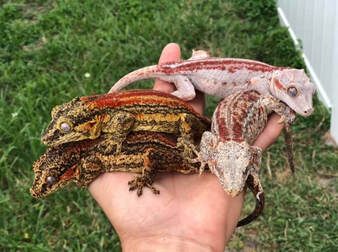
Gargoyle Gecko
(Rhacodactylus auriculatus)
Photo credit: TikisGeckos
QUICK FACTS
LIFESPAN
15-20 years
SIZE
7-9”
DIET
Primary frugivore, some insects
TEMPERATURE
Low 70-75℉, High 80-85℉
HUMIDITY
60-70%
HABITAT
Semi-Arboreal/Terrestrial
(min 18x18x24)
Gargoyle Geckos are the most terrestrial of all of the New Caledonian geckos, maintaining a semi-terrestrial/arboreal lifestyle. As such, a more horizontal enclosure with some height for climbing is recommended. They have a relatively small natural range in their native island of Grand Terre, isolated to the lower third of the island. They spend more time under dense foliage cover to avoid predation by birds and terrestrial predators and are slightly more insectivorous than their cousins. They tend to be slightly more handleable than some of the other geckos from this region, being a bit less prone to jump out of your hands! Their footpads are less developed than that of the more arboreal species, so they are not able to climb vertical surfaces as easily as a Crestie or Leachie. They come in beautiful shades of red, white, orange, gray, and black, with stunning patterns that change as they grow. They are relatively undemanding and easy to care for as pets, requiring very little on the part of the caregiver. Feeding consists of offering a small bowl of meal replacement formula for frugivorous reptiles (Repashy is a great brand), replaced every other day. Small insects can also be offered, but do not be surprised if it takes some time for your gecko to learn that the insects are food! Dubia roaches are ideal, small crickets are also acceptable. If your garg never takes to them, this is okay, but do ensure that their diet is nutritionally complete. Commercially available roach dishes can be purchased to prevent prey items from escaping into the enclosure. Remove all uneaten prey items from enclosure after 10 minutes.
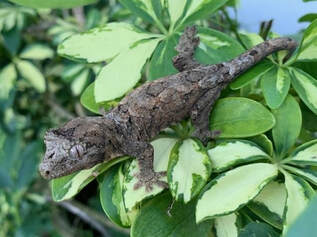
Chachouas Gecko
(Rhacodactylus Chahoua)
Photo credit: TikisGeckos
QUICK FACTS
LIFESPAN
15-20 years
SIZE
Up to 10”
DIET
Primary frugivore, some insects
TEMPERATURE
Low 70-75℉, High 80-85℉
HUMIDITY
60-75%
HABITAT
Semi-Arboreal (min 18x18x24)
These geckos, often referred to as Chahouas or “Chewies” by their keepers, are more recent additions to the pet trade. Until recently, Chahouas were classified in the same genus as Leachianus. The “prehensile” part of their name refers to their ability to hold on to branches and twigs with their highly tactile tail, much like a chameleon or opossum! They are also semi-arboreal/terrestrial, much like the Gargoyle gecko discussed above. Thus, a more horizontal enclosure with some height for climbing and decorations is preferred. Their coloration tends to be more brown, green, and gray, which gives them excellent camouflage against trees and foliage -- new morphs are seemingly constantly available, with yellow and red pigments also seen in captive bred animals. They are also nocturnal, so do not be surprised if you do not see much of your new friend during the day. Chewies are more likely than some of the other geckos to enjoy a feast of insects, so ensure your gecko is getting insect protein! Dubia roaches and crickets are both acceptable, dusted with calcium + D3. Also offer meal replacement diet for frugivores (Repashy is our favorite) and replace every other day. Juveniles actively growing can be offered Repashy daily with small insects 3-4 times per week -- they will need the extra protein to ensure they grow appropriately. As they age, they will require fewer insect proteins, but most Chewies do still enjoy their bugs through adulthood! Offer insects 2-3 times per week.
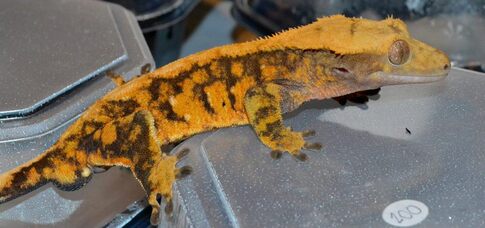 Male Crested Gecko photo courtesy of Melissa Borden
Male Crested Gecko photo courtesy of Melissa Borden
Crested Gecko
(Correlophus ciliatus)
QUICK FACTS
LIFESPAN
10-20 years
SIZE
5-8”
DIET
Primary frugivore, some insects
TEMPERATURE
Low 70-75℉, High 80-85℉
HUMIDITY
60-70%
HABITAT
Arboreal
Crested geckos are native to the southern aspect of New Caledonia, and among their terrain there are three distinct populations. They were originally discovered in the late 1800s and were thought to be extinct in the wild until 1994! Cresties live around 10-20 years and reach an average length of 7-9 inches long making them a small lizard ideal for apartment living. Crested geckos are excellent climbers due to the lamellae on their toes and the tip of their tail. Lamellae are hair like structures which allows the crestie to “adhere” to nearly any surface, including the hand of a keeper. Cresteds do not have a fully prehensile tail like a chameleon, but they are capable of autonomy (“tail dropping”) much like a leopard gecko, however, there is no regrowth of lost tails. The most regrowth noted on crested gecko tails is a small point affectionately known as a “duck butt” by some keepers. When this species was originally discovered in 1866 it was thought that crested geckos did not have long tails since nearly all the adults in the wild have lost their tails. Like all reptiles, crested geckos have a Jacobson’s organ on the roof of their mouth which accounts for the gecko’s natural behavior of licking the terrain. Crested geckos have an excellent sense of taste which can be frustrating to owners trying to convert their pets to a different diet. These interesting and popular little geckos are also nicknamed “Eyelash geckos”, which you can appreciate by their “eyelash-like” eyelids! They are known to leap out of their owner’s hands, so always ensure you are handling your gecko over a solid surface to prevent falls. They are available in many different colors and patterns, with most being shades of yellow, orange, red, brown, and cream. There are also “dalmatian” geckos with white bodies and black spots! Because of their unique look and relative ease of care, they are one of the most popular reptiles kept!
See our Crested Gecko specific caresheet for more information!
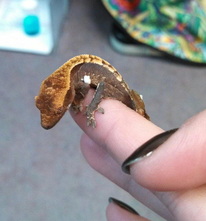
Sexing
The older a crested gecko is, the easier it is to definitely determine the sex of the gecko. Males develop a large bulge under the vent on the tail. This bulge is called a hemipenal bulge. Generally, the earliest most people can sex crested geckos is six months of age although some breeders can sex with fair certainty as early as four or five months old. The hemipenal bulge of males is usually wider than the tail base.
Reproduction
Copulation occurs at night generally. The male will subdue the female by holding her neck in his mouth and may bite hard enough to leave marks. These marks are generally minor and removed with the next shedding cycle. Females lay two eggs every three weeks during breeding.
A plastic lidded container with an access hole and several ventilation holes is ideal for nest boxes and allows the crested gecko to feel secure during egg laying. Vermiculite or sphagnum moss is used as substrates in the nesting boxes to promote nest digging and decrease stress on the female by offering a natural feeling medium. The vermiculite should be medium grade and mixed one part water to two parts vermiculite by weight. Properly mixed substrate will clump when squeezed together without water dripping out of it. This should be a few inches deep to allow digging. If sphagnum moss is preferred, the moss should be soaked in water until completely saturated and excess removed by squeezing. Lightly pack this substrate a few inches deep. Incubation is between 75 and 78 degrees Fahrenheit for 60-120 days. It is recommended to transfer the eggs, being incredibly careful not to alter the eggs position, to a Gladware or Ziploc container with vermiculite and holes drilled in the top for ventilation.
The older a crested gecko is, the easier it is to definitely determine the sex of the gecko. Males develop a large bulge under the vent on the tail. This bulge is called a hemipenal bulge. Generally, the earliest most people can sex crested geckos is six months of age although some breeders can sex with fair certainty as early as four or five months old. The hemipenal bulge of males is usually wider than the tail base.
Reproduction
Copulation occurs at night generally. The male will subdue the female by holding her neck in his mouth and may bite hard enough to leave marks. These marks are generally minor and removed with the next shedding cycle. Females lay two eggs every three weeks during breeding.
A plastic lidded container with an access hole and several ventilation holes is ideal for nest boxes and allows the crested gecko to feel secure during egg laying. Vermiculite or sphagnum moss is used as substrates in the nesting boxes to promote nest digging and decrease stress on the female by offering a natural feeling medium. The vermiculite should be medium grade and mixed one part water to two parts vermiculite by weight. Properly mixed substrate will clump when squeezed together without water dripping out of it. This should be a few inches deep to allow digging. If sphagnum moss is preferred, the moss should be soaked in water until completely saturated and excess removed by squeezing. Lightly pack this substrate a few inches deep. Incubation is between 75 and 78 degrees Fahrenheit for 60-120 days. It is recommended to transfer the eggs, being incredibly careful not to alter the eggs position, to a Gladware or Ziploc container with vermiculite and holes drilled in the top for ventilation.
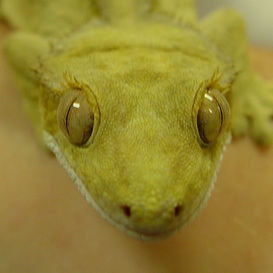
Grooming and Handling
All geckos new to a collection typically require a few days to acclimate before handling is attempted. This acclimation period also helps to preserve the tail which may be dropped during handling if the gecko perceives itself to be in danger. Generally, crested geckos will tolerate handling for around 15-20 minutes a day when they are fully acclimated.
These geckos do not require any form of grooming although occasional help with a particularly difficult shed may be needed but not often.
If you have any questions, please feel free to call us at 847-329-8709.
All geckos new to a collection typically require a few days to acclimate before handling is attempted. This acclimation period also helps to preserve the tail which may be dropped during handling if the gecko perceives itself to be in danger. Generally, crested geckos will tolerate handling for around 15-20 minutes a day when they are fully acclimated.
These geckos do not require any form of grooming although occasional help with a particularly difficult shed may be needed but not often.
If you have any questions, please feel free to call us at 847-329-8709.

